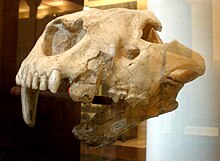Nimravides
| Nimravides Temporal range:
| |
|---|---|

| |
| Nimravides catacopis skull | |
| Scientific classification | |
| Kingdom: | Animalia |
| Phylum: | Chordata |
| Class: | Mammalia |
| Order: | Carnivora |
| Suborder: | Feliformia |
| Family: | Felidae |
| Subfamily: | †Machairodontinae |
| Tribe: | †Homotherini |
| Genus: | †Nimravides Kitts 1958 |
| Type species | |
| Nimravides thinobates Macdonald, 1948
| |
| Species | |
| |
| Synonyms | |
|
N. thinobates
N. pedionomus
N. hibbardi
| |
Nimravides is a genus of extinct saber-toothed cats that lived in North America during the Late Miocene, between 10.3 and 5.332 Ma.[1] Despite its scientific name, Nimravides does not belong to the Nimravidae, but is a true cat, belonging to the family Felidae.[2] Nimravides catacopsis, one of the largest and latest species, was quite large, measuring 100 cm (1.0 m) at the shoulder and was similar in size to a large tiger. It was also possessed of long, powerful legs and a long back. For many decades, it was also believed to be a member of the genus Machairodus, but, despite the similarities between them at first glance, based on autapomorphies in the skeleton, the two animals are too different to be classified as species of the same genus, and thus, Nimravides remains separate as its own genus within the Homotherini.[3]
References[]
- ^ Paleobiology Database: Nimravides
- ^ Larry D.Martin: Felidae in Evolution of Tertiary Mammals of North America, Volume 1: Terrestrial Carnivores, Ungulates, Ungulatelike Mammals, Cambridge University Press, 1998
- ^ Antón, Mauricio (2013). Sabertooth. Bloomington, Indiana: University of Indiana Press. p. 123. ISBN 9780253010421.
External links[]
- Homotherini
- Miocene carnivorans
- Prehistoric carnivoran genera
- Miocene mammals of North America
- Prehistoric carnivoran stubs
- Feline stubs
